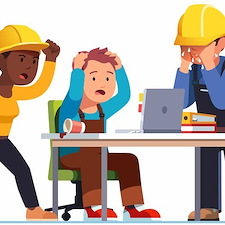Make It Easy: Easy to Use Contractor Websites


Many factors that go into the structure and optimization of websites are behind the scenes. Rich snippet data, proper image format and compression, and minified data files are all factors that help to improve the rank of your web site, but that users will never have to directly deal with.
When users ultimately do click on your link and view your website, making sure prospective clients can properly use your site. Getting them interested enough to not click away is vital. Let's discuss contractor marketing UI (user interface) and UX (user experience) principles will help us to make easy to use contractor websites.
About User Interface
User Interface refers to manner in which we interact and the elements that people will use to interact with your web site – In layman's terms, your menu and buttons . While crazy, outside-of-the-box navigation can be very visually appealing, it can be difficult for users to operate.
When it comes to basic UI for contractor websites, the simplest options are usually the best ones. Top navigation menu bars have become the accepted industry norm, and allow users to easily see all of the options available. Dropdown items in each menu allow to you identify more key services in detail while still being concise and easy to use.
Sidebar menus, especially as main navigation, have fallen out of favor with users. Instead, placing specific elements that we want users to select / that users would actively seek out anyway is a good way to create a call-to-action and increase conversions. For remodelers, a button to view your previous work portfolio is vital. For service contractors, a coupons section may entice new customers to try your services. For all contractors, either a quick contact form or button linked to your main contact page is a must on your sidebar.
UI for Mobile Users
Browsing web sites on mobile devices is a completely different experience than on desktops. Mobile browsing has its own routines and accepted methods. That's why responsive web design has been so popular – It allows users a way to optimally view and interact with your website, regardless of screen size. As far as mobile menus, creating "hamburger" drop down menus allows you to display an entire menu's worth of content while taking up a minimal amount of mobile screen real estate.
About User Experience
To use two big marketing buzz words, UX is the synergy of your online experience. It is less about specific elements that create your site, and more about the experience of using your web site. Understanding UX is like trying to establish the personality of your online presence. Many factors go into your user's experience, from simple measurable factors like page loading speed to more elusive factors like visual attractiveness.
What Users Want
Presenting exactly what a customer is looking for is key to the user experience. By trying to understand the mindset of a website visitor, we can further understand what the user wants to happen when they access a web page.
Landscaping and remodeling customers are looking for work samples, so having larger banners, parallax design, and easy to find portfolio would be important to the user. Customers looking for emergency plumbing services on their phone will want an easy to dial phone number for quick use. Understanding what your clients want and need, and giving them that information, is vital to a positive user experience.
What Users See & Read
Far more elusive is determining the optimal visual styling for your customer. Overall, creating a simple, cohesive look – one that is consistent throughout your company's online and offline marketing – is the most important.
Design trends are just that, they are trends. Web 2.0 demanded all buttons be glossy. Skeuomorphics required that digital media have the look of physical materials. Most recently, flat design trends require simplicity in style. While paying attention to what is satisfying users now is important, know that web design is a continual evolution of style and that the bleeding edge of cool isn't all that far off from old hat in the big scheme of things.
Your web site's content, written and visual, must be useful to the end user. By presenting well-crafted articles, good looking portfolio images, and reviews from other customers, you're giving quality content that potential customers can actually use in their decision making processes.
"My Clients Aren't Looking for Art – So Why Does UI and UX Matter if I'm a Contractor?"
On the most basic level, quality UI and UX isn't about creating the sexiest web site. It is about making a product that simply works. Quality UI and UX make it easy to use your website.
Frustration with a web site – be it slow page speeds, not being able to find a contact page, or the inability to tap on a phone number to place a call from a mobile device – is what makes online marketing not work. No matter how much SEO effort you put in or how much you spend on PPC campaigns, people have to be able to understand how to use your site and want to stay to get more information.

About Chris Lonergan
Chris Lonergan has over 12 years of contractor marketing experience with Footbridge Media. With a background in web design, print design, content creation, and online marketing, Chris is focused on providing quality marketing and business solutions in the construction and service industries - helping small business owners to more efficiently manage their companies and grow their operations.
Chris Lonergan has previously contributed to and/or been featured in PM Magazine (Plumbing & Mechanical | Contractors x Engineers), theNEWS (ACHR - Air Conditioning | Heating | Refrigeration), Service Roundtable's blog, inPAINT Magazine, the SMB Marketing Agency Show, and the Green Industry Podcast. Chris is also a past SGI/CertainPath breakout session presenter.





